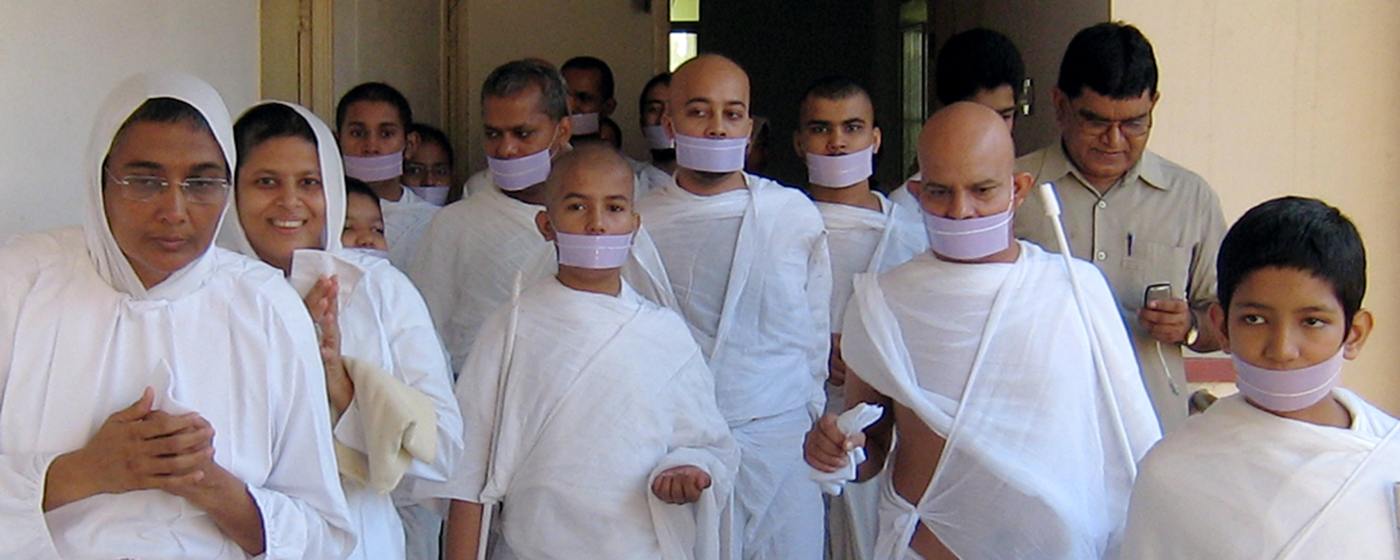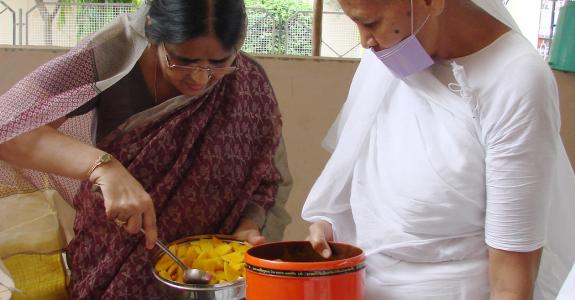The joy of asceticism
The Jain religious community has lived ascetically for 2,500 years. Shivani and Sanjeev Bothra travelled to Gangashahar to talk to monks and nuns about the topic of pleasure.
To unveil the source of joy in asceticism, we scouted on a two-day road journey to the town of Gangashahar, 250 kilometres from our home in Jaipur city. My co-researcher Sanjeev took charge of capturing the spirit of monks and nuns digitally with his camera, while I set forth to record their joy through words. We found Gangashahar to be an appropriate place as there was an annual function at which 500 Jain monks and nuns would be assembled to celebrate.
By and large, ascetics are associated with religious traditions. Jainism, one such tradition, is a very ancient religion of India and has often been identified as the “religion of asceticism”. It has two main branches – Digambara and Svetambara; in both sects, asceticism and nonviolence are central and prominent elements. So what exactly does Jain asceticism look like? Three things instantly come to my mind: monks either dressed in white robes with rectangular white mouth coverings or those who go naked; secondly, walking barefoot; and finally, ascetics with blissful faces disseminating knowledge. Austerity, along with a routinely followed long list of rules and regulations, is something I also associate with asceticism. Although, a non-ascetic like me instantly asks what causes people to follow such rules, what drives girls and boys, men and women to voluntarily give up their families, often high professional jobs, along with the comforts of living in the 21st century?

We arrived late at night and settled ourselves in the guesthouse about a kilometre from the large community-owned mansion where the monks were staying. The nuns, being larger in number, were dispersed in many small and large havelis (traditional homes) owned by their followers. The next day we woke up early and discovered a dense fog making everything calm and peaceful. It seemed the serene quiet feel of the small town was in sync with the presence of the joyful spirit of the monks and nuns.
Having strong images of ascetic practices in my mind from childhood stories and fables, I had anticipated the Jain ascetics to be thin, starved and desolate wanderers. I knew they possessed nothing but a pot for collecting alms and a “broom”—which they always use to gently sweep away the small creatures on the ground to prevent stepping on them. My image of an ascetic was partly right, but drastically wrong when it came to expecting tired, skin-over-bone, pain-stricken faces.
I was in the midst of a whirlpool of ascetics who were dispersed across an area of one square kilometre. Monks and nuns were divided into small and big groups with distinct individual or group responsibilities. Many were engaged in collecting alms, while others in stitching, washing, reading and writing. In the grand hall there were scattered bunches of householders engaged in conversations with ascetics, at the same time crowds gathered around some other ascetics. Everyone seemed so preoccupied that I was hesitant to disturb the tranquillity of the space, until my eyes spotted an old monk with compassionate eyes.
What is the joy of asceticism?
Taking advantage of his experience, I inquired what, besides a change in clothes, is the fundamental difference between two radically distinct ways of life—ascetic and layperson? The monk replied: “A layperson is attached to the body, to family, society, nation and the world around, whereas the ascetic is detached from these. An ascetic is attached to the soul, which is eternal and exists in all times—past, present and future. Even for an ascetic it is impossible to maintain the physical body, without the use of worldly goods, however, one can live with detachment towards material possessions. Craving for food, clothing and shelter is the cause of unhappiness and an ascetic is naturally free from these worldly paraphernalia.” For me this generic message was philosophical, incisive and appealing.
Therefore, I posed a direct question to one young nun: “What is the joy of asceticism?” She answered with a rhetorical question: “You tell me, is creating hurdles for others called joy? Basically, we live in the same physical world in which non-ascetics live. For instance, we eat, drink, walk, travel long distances, but the fundamental difference in the two lifestyles is that we as ascetics will not consciously hurt or hinder the joy of another being.”
When it comes to food and how it relates to joy and happiness, I have as a layperson the independence of choosing from a countless variety of items. I end up loading up my stomach till I’m full, but then often feel heavy and joyless afterwards. So, I deliberately asked what kind of joy there is in collecting alms. She replied: “Joy is in following the rules of collecting alms.”
Can ascetics be isolated from the physical world in which they live?
Such a statement fuelled my curiosity and so I investigated more deeply their ways of collecting alms and the food they eat. Though the rules vary according to the sect, some accepting food once a day while others twice or thrice a day. However, Jain monks and nuns neither prepare food nor have it prepared for them. Out of devoutness, lay followers make the best food they can according to their individual capacities, to ensure the well-being of the mendicants. Even though, householders offer them ample amounts of food, monks and nuns collect only small portions of what is offered to them in their bowls. Their way of collecting alms is called gochari, which technically means “grazing cow”. Just as cows move from place to place, taking portions of grass without uprooting them, Jain mendicants also move from house to house, collecting only small portions of food so that the family does not need to cook more for themselves.
Heading out to collect alms
Jain ascetics accept purely vegetarian food, while avoiding certain root vegetables, such as onions, garlic, potatoes, carrots, and so on. As a matter of course, their breakfast consists of fruits, milk, porridge and nuts. During lunch they collect chapati (Indian bread), cooked vegetables, rice and lentils. Dinner is also a regular vegetarian meal. Accepting dairy products is not a problem for Jain monks and nuns. Yet they strictly adhere to not eating or drinking anything – not even water – before sunrise and after sunset.
While driving back after two long days, I recall my observations of monks and nuns blissfully sleeping without any external cooling equipment in the afternoon, and equally comfortable in the coldest nights. It appears to me, that asceticism is an individual’s spiritual journey disconnected from worldly affairs. But can these ascetics actually isolate themselves from the physical world in which they live? As world citizens, are they not concerned about prevalent world problems demanding urgent attention? If yes, then how do they address some of the pressing needs of global society? As I see it, walking, talking, eating and material possessions for need not for greed is the ascetic way of living. Such a minimalist way of living may not be profitable for a money-based economy, but surely makes a lot of sense environmentally.
As I compile their responses, I begin to feel personally motivated to take small steps that will draw me closer to nonviolent ways of living by limiting the number of gadgets, clothing, footwear, bags I possess – and eating and living with contentment.















